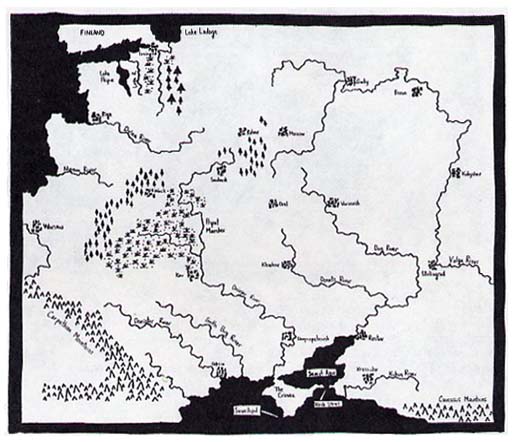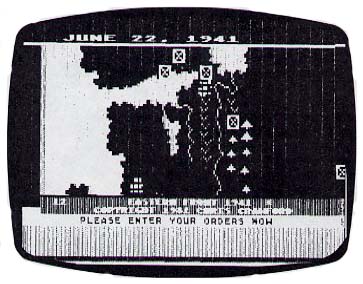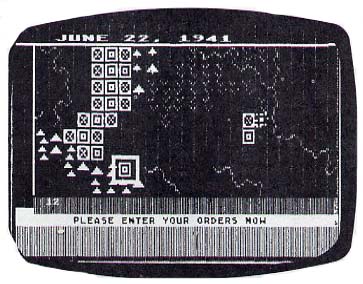Eastern Front
The Atari Goes to War
Why would a multimillionaire ex-movie star seek a job as President of the United States with a salary of a mere $200,000 a year, or the head of a major corporation join the Cabinet with a salary even lower? The answer is that of all the success drives that captivate the human imagination, the strongest is the lust for power. Power is far headier than sex, wealth, or fame, and may make the others easier to obtain.
No exercise of power can compare with the job of a commanding general in time of war, marshaling millions of soldiers and the industrial resources of many nations in an all-out drive for supremacy on a battlefield that covers a continent. One of the largest such campaigns in human history was Operation Barbarossa, the German invasion of Russia that began in the summer of 1941. During the course of this four year campaign, nearly 20 million human lives were lost. Eastern Front, one of the best microcomputer war games ever produced, allows the player to take on the role of the commander of the German army, and try to do better than the German forces actually did.
In the past, among war games, board games have had a major advantage over computer games. War gamers like to operate on a theatre level, with an overview of dozens or even hundreds of units scattered over a wide area. Until now the limitations of computer displays have made it difficult to get a satisfying situation map.
Special Features
In Eastern Front, Chris Crawford has produced the first really satisfactory solution to the display problem by using the fast fine-scrolling ability of the Atari computer to produce a magnificent map of Eastern Russia that occupies ten display screens.
|
|
Nearly every aspect of the game is a technical masterpiece. Eighteen colors are used on the screen at a time. Player missile graphics are used to move a cursor over the map to give instructions without disturbing the map underneath. Several different redefined character sets permit the natural mixing of a colorful and detailed terrain with a text display. Display list interrupts are used to set the weather conditions, with ice gradually taking over the rivers in winter and receding in the spring, and making the player deal with mud and snow at different times in different areas.
The program uses intricate artificial intelligence routines and multiprocessing to control the Russians and their allies. This means that the longer the German player takes to form his strategy, the better the Russian strategy will be. The Russian side can analyze its position, recognize danger and opportunity, avoid traffic jams, recognize the effects of terrain, and plan accordingly.
The human engineering of the game is also a major accomplishment, with all information entered by the player using only the joystick, trigger button, start button, and space bar. This eliminates the drudgery of most war gaming. The multiprocessing even allows the German player to move the cursor around and view different sections of the map while the battles are taking place. Of course, since all battles and movement are real time, it is impossible to see everything that is happening. Excellent sound effects do indicate the extent of the overall action.
The computer adds a great deal to wargaming, particularly by providing a dynamic environment in place of the static nature of board games. Each turn, representing one week of actual time, is broken down into 32 time periods in which units move and fight. Thus a player might program a particular unit to attack an adjacent enemy unit and move toward a city. During the course of a single turn, that unit might destroy the first enemy unit, move forward to engage a unit behind it, force the second enemy to retreat, turn toward the city, and engage in battle a third enemy unit that has come up from the reserves during the turn. Terrain affects both movement and combat, with rivers, forests, marshes, mountains, and cities to complicate strategy.
Playing the Game
At the beginning of the game the German commander has the advantages of concentrated force, short supply lines and superior mobility. However, the Russians have overwhelming numbers, vast territory, and the Russian winter on their side. The object of the game for the German commander is to push as large a force as possible as far East as possible and maintain them. Extra points are awarded for capturing key Russian cities. The Russians are trying to move their forces West, which also affects the German player's score. The score, which is calculated from week to week, can range from 0 to 255 points.
It is fairly easy to get a high score by early fall, but nearly impossible to hold that advantage over the winter.

|
|
Figure 3. The instruction book contains a map of the whole area covered by the game. Only one tenth of this area is displayed on the screen at one time. |
During the war, large concentrations of German troops were bogged down in the Pripet marshes between Minsk and Kiev, allowing the Russians to concentrate their forces. This is a recipe for disaster in the game, as it was also a German disaster in real life. My own best strategies have involved splitting up my forces to prevent the Russians from concentrating theirs, and avoiding combat with superior mobility unless I had overwhelming superiority. Another possibility might be to crash through the Pripet marshes and break into open territory beyond, splitting forces at that time. Uncertain winter supply lines require that the German player draw back during that season.
Regardless of my strategy, my success rate in my first ten games was abysmal. The game ends automatically after the week of March 29, 1942, and in nine of my games my score was 0 on that date. In the one game where I held a score to the end, I seized the city of Leningrad (worth 10 points) and defended it to practically my last man. My total score was 10 points.
After many hours of play, I found only a few real weaknesses. Giving all those instructions with the joystick can give you a sore palm and wrist. The lack of a clearcut set of victory conditions is frustrating, as is the overwhelming advantage of the Russians. I would also like an option to be able to see the whole theatre at once, however limited the detail might be at that time. The designer mentions in the instructions that test players became frustrated with random logistics problems and traffic jams, but I tend to think these are realistically handled.
Recommendation
I have no hesitation in calling this one of the very best war games available for a personal computer. It is also a virtuoso demonstration of the awesome built-in capabilities of the Atari computer. This game literally could not be done on any other computer in as satisfactory an execution. By all means, if you are at all interested in strategy games, buy it.
If you are a serious war gamer, buy it even if you have to buy a computer in order to run it. Eastern Front comes on disk, requiring 32K of RAM, for $29.95. It is also available on cassette, requiring 16K of RAM, for $26.95. The cassette version can be downloaded from MicroNet at a price of $23.25.
Table of Contents
Previous Section: Speedread +
Next Section: Missile Command & Asteroids



